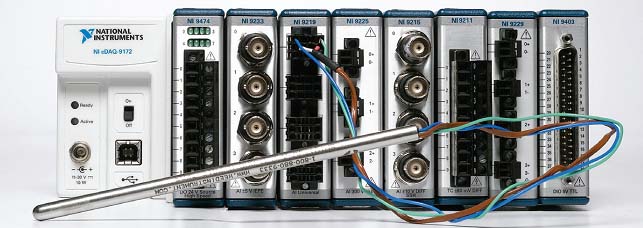Functional Prototyping of Embedded Devices
Virtual simulations are certainly valuable, but you are basically operating on the conceptual level. Ultimately, you have to test designs in the real world.
Latest News
June 1, 2010
By Tom Kevan
Anxious to be the first to market with innovative products, many device and machine makers cut corners and minimize prototyping before going to production. All too often, this results in less than desirable functionality or robustness, and high development costs.
 The CompactDAQ I/O platform enables PC-based prototypes that need to connect to to real-world sensors. The hot-swappable C Series I/O modules feature integrated signal conditioning. |
The challenges are compounded when working on embedded systems that incorporate sophisticated sensing and control components. While these components can increase product performance, they can also increase the risk of poor product reliability. Without some form of system characterization and design validation, the chance of creating an inferior product increases significantly. “On the electrical side, you would be amazed at how many people go right into schematic capture tools and start laying out boards,” says Matt Spexarth, embedded product manager at National Instruments.
A better approach leverages functional prototyping, which simulates the final design’s materials and functionality to the greatest extent practical. Functional prototyping of embedded devices enables the selection of correct components.
Sensing, Control, and I/O
Including sensing and control elements also means adding input and output to your prototype, which can be a challenge. It is, however, necessary to ensure that the final design will deliver a reliable solution.
By adding sensor inputs and control outputs, engineers can prove that the design works. Data derived from functional prototyping also helps you refine functional requirements and validate performance.
Choosing between analog and digital sensors is a series of tradeoffs. Each comes with its own advantages and disadvantages. This is where functional prototyping helps you make intelligent choices and simplifies iterative evaluations.
Analog sensor signals must be conditioned and digitized, so they require more components (e.g., converter, signal conditioning, and connectors) to complete the data acquisition process. This type of sensor usually has greater resolution and is less expensive than digital sensors.
Signal processing components are tailored for specific sensors, so as you evaluate different sensors during prototyping, you must adjust and reconfigure the processing components in the data acquisition chain.
On the other hand, because digital sensors incorporate signal conditioning and digitization at the chip level, fewer components must be added for data acquisition. This simplifies both the prototyping and the final system. Digital sensors also offer cost and development advantages.
“Embedded digital sensor technology has lowered the cost and simplified the inclusion of measurement into an embedded system,” says Spexarth. “The proliferation of these new sensors is evident in everything from automobiles to handheld devices.”
The downside of using digital sensors is that they introduce additional complexity. Specifically, they require unique driver interfaces to enable communications.
The Final Analysis
Functional prototyping is essential to characterize and validate sensors and prove an embedded device will perform reliably, meet design requirements, and have market value. Therefore, it’s important to select a prototyping platform than can connect to a wide variety of sensors, ranging from traditional analog sensors to more complex MEMs digital sensors.
“The fastest thing you can do to prove your concept is to build a functional prototype,” says Spexarth. “You can prove the concept of a device when speaking with investors or venture capitalists to demonstrate that your device has technical or market merit.”
Sensor Offerings NI CompactRIO Control and Acquisition System CompactRIO combines an embedded real-time processor, an FPGA, and hot-swappable I/O modules. Each I/O module is connected directly to the FPGA, providing low-level customization of timing and I/O signal processing. The FPGA is connected to the embedded real-time processor via a high-speed PCI bus. CompactRIO is powered by LabVIEW, which has data transfer mechanisms to pass data from the I/O modules to the FPGA, and also from the FPGA to the embedded processor for real-time analysis, post-processing, data logging, and communication with a networked host computer. Features: MathWorks Simulink 7.5 Add-on products extend Simulink software to multiple modeling domains, as well as provide tools for design, implementation, and verification and validation tasks. Simulink is integrated with MATLAB, providing access to tools that let you develop algorithms, analyze and visualize simulations, create batch processing scripts, customize the modeling environment, and define signal, parameter, and test data. Key Features Analog Devices ADIS16223 iSensor Accelerometer The ADIS16223 is available in a +/- 70g dynamic range, across three axes. The 22kHz sensor resonance and 72.9 Ksps sample rate provide a flat frequency response from DC to 10kHz, which is desirable for most machine-health applications. With the SPI interface, configuration options include condition monitoring/alarm settings, capture buffers configuration control, and embedded self-test control. The data capture function has three different trigger modes, allowing in-system adaptation of the sensor to the end-systems product lifecycle. Features and Benefits: |
More Info:
Analog Devices
Contributing Editor Tom Kevan is based in New Hampshire and is DE’s mechatronics, PLM, and systems expert. Send your comments about this article to [email protected].
Subscribe to our FREE magazine, FREE email newsletters or both!
Latest News
About the Author
DE’s editors contribute news and new product announcements to Digital Engineering.
Press releases may be sent to them via [email protected].






